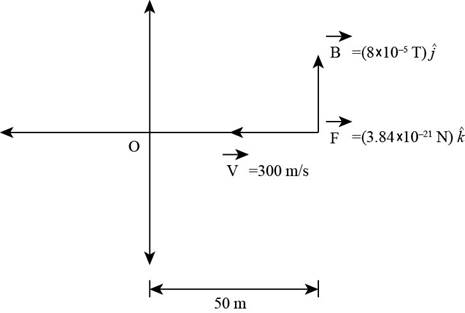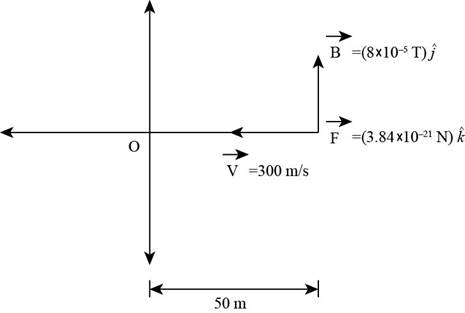
Concept explainers
In a long, .straight, vertical lightning stroke, electrons move downward and positive ions move upward and constitute a current of magnitude 20.0 kA. At a location 50.0 m east of the middle of the stroke, a free electron drifts through the air toward the west with a speed of 300 m/s. (a) Make a sketch showing the various vectors involved. Ignore the effect of the Earth's magnetic field. (b) Find the vector force the lightning stroke exerts on the electron. (c) Find the radius of the electron’s path. (d) Is it a good approximation to model the electron as moving in a uniform field? Explain your answer. (e) If it does not collide with any obstacles, how many revolutions will the electron complete during the 60.0-µs duration of the lightning stroke?
(a)
To draw: The various vectors involved to represent the lightning stroke of the electron and the positive ions.
Answer to Problem 30.16P
The various vectors involved to represent the lightning stroke of the electron and the positive ions as shown below,

Explanation of Solution
Given info: The electrons move downward and the positive ions move upwards. The magnitude of the uniform current is
According to the Ampere’s right hand thumb rule, the index finger represents the direction of the velocity vector
Write the expression for the magnetic field.
Here,
Substitute
Write the expression for the direction of the magnetic field according to the ampere’s law of the magnetic field.
Write the expression for the velocity vector pointed towards the west.
Write the expression for the force vector on the electron,
Here,
Substitute
From the result of the force vector, field vector and velocity vector the as shown below,

Figure (1)
(b)
The vector force lightning stroke exert on the electron.
Answer to Problem 30.16P
The vector force lightning stroke exert on the electron is
Explanation of Solution
Given info: The electrons move downward and the positive ions move upwards. The magnitude of the uniform current is
From the part (a), the vector force on the electron.
Conclusion:
Therefore, the vector force lightning stroke exert on the electron is
(c)
The radius of the electron path.
Answer to Problem 30.16P
The radius of the electron path is
Explanation of Solution
Given info: The electrons move downward and the positive ions move upwards. The magnitude of the uniform current is
Write the expression for the radius of the electron path.
Here,
Substitute
Conclusion:
Therefore, the radius of the electron path is
(d)
Whether it is a good approximation to model the electron as moving in a uniform field.
Answer to Problem 30.16P
The electron was not moving in a uniform field cause of the magnetic field is varies from the location of the lightning stroke.
Explanation of Solution
Given info: The electrons move downward and the positive ions move upwards. The magnitude of the uniform current is
From the figure (1) of the part (a), the magnitude of the magnetic field is varies with the distance of the light stroke towards the positive
Conclusion:
Therefore, the electron was not moving in a uniform field cause of the magnetic field is varies from the location of the lightning stroke.
(e)
The number of the revolutions will the electron complete during the
Answer to Problem 30.16P
The number of the revolutions will the electron complete during
Explanation of Solution
Given info: The electrons move downward and the positive ions move upwards. The magnitude of the uniform current is
From the part (c) the radius of the electron path,
Write the expression for the number of the revolution complete by the electron.
Here,
Substitute
Conclusion:
Therefore, the number of the revolutions will the electron complete during
Want to see more full solutions like this?
Chapter 30 Solutions
Physics for Scientists and Engineers (AP Edition)
- Please solve and answer this problem correctly please. Thank you!!arrow_forwarda) Use the node-voltage method to find v1, v2, and v3 in the circuit in Fig. P4.14. b) How much power does the 40 V voltage source deliver to the circuit? Figure P4.14 302 202 w w + + + 40 V V1 80 Ω 02 ΣΑΩ 28 A V3 + w w 102 202arrow_forwardPlease solve and answer this problem correctly please. Thank you!!arrow_forward
- You're on an interplanetary mission, in an orbit around the Sun. Suppose you make a maneuver that brings your perihelion in closer to the Sun but leaves your aphelion unchanged. Then you must have Question 2 options: sped up at perihelion sped up at aphelion slowed down at perihelion slowed down at aphelionarrow_forwardThe force of the quadriceps (Fq) and force of the patellar tendon (Fp) is identical (i.e., 1000 N each). In the figure below angle in blue is Θ and the in green is half Θ (i.e., Θ/2). A) Calculate the patellar reaction force (i.e., R resultant vector is the sum of the horizontal component of the quadriceps and patellar tendon force) at the following joint angles: you need to provide a diagram showing the vector and its components for each part. a1) Θ = 160 degrees, a2) Θ = 90 degrees. NOTE: USE ONLY TRIGNOMETRIC FUNCTIONS (SIN/TAN/COS, NO LAW OF COSINES, NO COMPLICATED ALGEBRAIC EQUATIONS OR ANYTHING ELSE, ETC. Question A has 2 parts!arrow_forwardThe force of the quadriceps (Fq) and force of the patellar tendon (Fp) is identical (i.e., 1000 N each). In the figure below angle in blue is Θ and the in green is half Θ (i.e., Θ/2). A) Calculate the patellar reaction force (i.e., R resultant vector is the sum of the horizontal component of the quadriceps and patellar tendon force) at the following joint angles: you need to provide a diagram showing the vector and its components for each part. a1) Θ = 160 degrees, a2) Θ = 90 degrees. NOTE: USE DO NOT USE LAW OF COSINES, NO COMPLICATED ALGEBRAIC EQUATIONS OR ANYTHING ELSE, ETC. Question A has 2 parts!arrow_forward
- No chatgpt pls will upvotearrow_forwardThe force of the quadriceps (Fq) and force of the patellar tendon (Fp) is identical (i.e., 1000 N each). In the figure below angle in blue is Θ and the in green is half Θ (i.e., Θ/2). A) Calculate the patellar reaction force (i.e., R resultant vector is the sum of the horizontal component of the quadriceps and patellar tendon force) at the following joint angles: you need to provide a diagram showing the vector and its components for each part. a1) Θ = 160 degrees, a2) Θ = 90 degrees. NOTE: USE ONLY TRIGNOMETRIC FUNCTIONS (SIN/TAN/COS, NO LAW OF COSINES, NO COMPLICATED ALGEBRAIC EQUATIONS OR ANYTHING ELSE, ETC. Question A has 2 parts!arrow_forwardNo chatgpt pls will upvotearrow_forward
- No chatgpt pls will upvotearrow_forwardSolve and answer the question correctly please. Thank you!!arrow_forward་ The position of a particle is described by r = (300e 0.5t) mm and 0 = (0.3t²) rad, where t is in seconds. Part A Determine the magnitude of the particle's velocity at the instant t = 1.5 s. Express your answer to three significant figures and include the appropriate units. v = Value Submit Request Answer Part B ? Units Determine the magnitude of the particle's acceleration at the instant t = 1.5 s. Express your answer to three significant figures and include the appropriate units. a = Value A ? Unitsarrow_forward
 Physics for Scientists and Engineers: Foundations...PhysicsISBN:9781133939146Author:Katz, Debora M.Publisher:Cengage Learning
Physics for Scientists and Engineers: Foundations...PhysicsISBN:9781133939146Author:Katz, Debora M.Publisher:Cengage Learning Physics for Scientists and Engineers, Technology ...PhysicsISBN:9781305116399Author:Raymond A. Serway, John W. JewettPublisher:Cengage Learning
Physics for Scientists and Engineers, Technology ...PhysicsISBN:9781305116399Author:Raymond A. Serway, John W. JewettPublisher:Cengage Learning
 Principles of Physics: A Calculus-Based TextPhysicsISBN:9781133104261Author:Raymond A. Serway, John W. JewettPublisher:Cengage Learning
Principles of Physics: A Calculus-Based TextPhysicsISBN:9781133104261Author:Raymond A. Serway, John W. JewettPublisher:Cengage Learning Glencoe Physics: Principles and Problems, Student...PhysicsISBN:9780078807213Author:Paul W. ZitzewitzPublisher:Glencoe/McGraw-Hill
Glencoe Physics: Principles and Problems, Student...PhysicsISBN:9780078807213Author:Paul W. ZitzewitzPublisher:Glencoe/McGraw-Hill College PhysicsPhysicsISBN:9781305952300Author:Raymond A. Serway, Chris VuillePublisher:Cengage Learning
College PhysicsPhysicsISBN:9781305952300Author:Raymond A. Serway, Chris VuillePublisher:Cengage Learning





